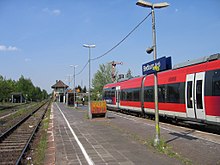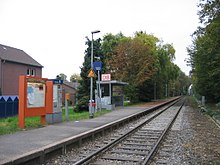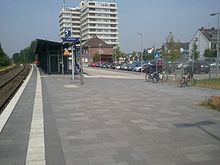Erftbahn
| Bedburg – Mödrath | |||||||||||||||||||||||||||||||||||||||||||||||||||||||||||||||||||||||||||||||||||||||||||||||||||||||||||||
|---|---|---|---|---|---|---|---|---|---|---|---|---|---|---|---|---|---|---|---|---|---|---|---|---|---|---|---|---|---|---|---|---|---|---|---|---|---|---|---|---|---|---|---|---|---|---|---|---|---|---|---|---|---|---|---|---|---|---|---|---|---|---|---|---|---|---|---|---|---|---|---|---|---|---|---|---|---|---|---|---|---|---|---|---|---|---|---|---|---|---|---|---|---|---|---|---|---|---|---|---|---|---|---|---|---|---|---|---|---|
|
today's course of the Erftbahn
| |||||||||||||||||||||||||||||||||||||||||||||||||||||||||||||||||||||||||||||||||||||||||||||||||||||||||||||
| Route number (DB) : | 2581 (Bedburg – Martinswerk) 2601 (Martinswerk – Mödrath) |
||||||||||||||||||||||||||||||||||||||||||||||||||||||||||||||||||||||||||||||||||||||||||||||||||||||||||||
| Course book section (DB) : | 481 | ||||||||||||||||||||||||||||||||||||||||||||||||||||||||||||||||||||||||||||||||||||||||||||||||||||||||||||
| Route length: | 12.7 km | ||||||||||||||||||||||||||||||||||||||||||||||||||||||||||||||||||||||||||||||||||||||||||||||||||||||||||||
| Gauge : | 1435 mm ( standard gauge ) | ||||||||||||||||||||||||||||||||||||||||||||||||||||||||||||||||||||||||||||||||||||||||||||||||||||||||||||
| Dual track : | - | ||||||||||||||||||||||||||||||||||||||||||||||||||||||||||||||||||||||||||||||||||||||||||||||||||||||||||||
|
|||||||||||||||||||||||||||||||||||||||||||||||||||||||||||||||||||||||||||||||||||||||||||||||||||||||||||||
The Erftbahn is a railway line in North Rhine-Westphalia . The non- electrified line was originally built and operated by the Bergheimer Kreisbahn as a meter- gauge small railway. The line was later converted to standard gauge .
The Erftbahn carries the course book number 481 of the Deutsche Bahn . The Erft-Bahn is the only regional train line that runs on it .
Operation and history
The Bedburg - Horrem - Mödrath line was built as part of the Bergheimer Kreisbahn. The line was designed in meter gauge and was built by the construction company Lenz & Co. , which initially also had the operational management. The line between Mödrath and Zieverich (and further towards Elsdorf) was opened on November 5, 1896 for goods traffic and on February 20, 1897 for passenger traffic. The extension from Zieverich to Bedburg was opened on May 8, 1897. Although initially built with narrow gauges, regular-gauge expansion had been considered. The subgrade was correspondingly wide, standard track sleepers were laid at shorter intervals and a heavy superstructure was used. In 1904 the third rail was installed. After that, the passenger trains ran on the narrow gauge, the freight trains on the standard gauge .
In 1913, the Prussian State Railroad took over the Bergheimer Kreisbahn, the option to do so was included in the concession, and narrow-gauge traffic was discontinued. After the First World War, the line was relocated and rehabilitated on its own track where possible.
On the Mödrath – Horrem section, passenger traffic was discontinued on May 28, 1972 and freight traffic on October 1, 1978.
The Horrem - Quadrath-Ichendorf section was electrified in 1983 because of the high volume of freight traffic. In 1996, however , the overhead line was dismantled.
Since June 2, 1991 the trains have been running continuously from Neuss to Horrem , and also to Cologne during rush hour . From December 15, 2002, the train service to Cologne was extended all day, and since December 14, 2014 also on Sundays and public holidays.
On November 1, 2007, the line was connected to the electronic signal box. On this occasion, all older level crossings were also brought up to the state of the art with flashing lights. At the Sandstrasse level crossing in Quadrath-Ichendorf, which was equipped with full barriers, a gatekeeper had previously checked visually whether the tracks were free of vehicles; this is now done by a radar scanner.
Erft Railway
The regional train runs from Bedburg (Erft) via Bergheim (Erft) to Horrem or to Cologne Messe / Deutz (with a stop in Horrem on platform 19). It bears the line number RB 38 and is operated every half hour on the Bedburg - Horrem section and every hour on the rest of the route from DB Regio NRW .
In addition to the Erftbahn itself, the Erft-Bahn between Horrem and Cologne is connected via the high-speed line Cologne – Aachen .
Until the timetable change on December 10, 2017, the Erft-Bahn operated from Cologne Messe / Deutz via Bedburg to Düsseldorf main station (on weekends to Neuss main station ). This section, located in the area of the Rhein-Ruhr transport association , was taken over in December 2017 by a new line RB 39 (Düssel-Erft-Bahn) , which is operated by the Vias transport company. Passengers who want to go beyond Bedburg now have to change there. The reason for this division is the planning of the responsible authority south of Bedburg, Zweckverband Nahverkehr Rheinland , to electrify the Bedburg – Cologne section and to replace the regional train with a line from the Cologne S-Bahn . Furthermore, first class was omitted in the Erft Railway ; The reasons are their low usage and the trains that are always overcrowded during rush hour, which is intended to increase capacity.
Vehicle use
Before the 1990s, the series 515 battery-powered railcars shaped passenger traffic on the line. In the 1990s, diesel locomotives of the 212 series and later 215 or 218 were used together with Silberlingen .
In the late 1990s, the locomotive hauled trains were diesel multiple units of the 628 series replaced. In 2003, two and three-part railcars of the 643 series (Bombardier Talent) were added, so that both vehicle types were used until the 2010/2011 timetable change. Until December 2014, only class 628 railcars were used again on the Erft-Bahn , mostly in double traction, while individual railcars of this class ran between Bedburg and Horrem.
From December 2014 to December 2016 only vehicles of the 644 series were used, on the entire route between Düsseldorf main station and Cologne Messe / Deutz in double traction and between Bedburg and Horrem or Grevenbroich and Neuss, as before, additional individual vehicles. From the timetable change in December 2016 to mid-2017, a few vehicles from the 628 series ran between Bedburg and Horrem again, as some of the 644 series vehicles were renovated. These were repainted, got new seat cushions and headrests and were thoroughly cleaned.
The class 644 railcars will remain on the new RB 38 after the major renovation. It was planned to let the railcars run as a triple unit on the longer train route (Bedburg – Cologne) . However, this failed due to the length of the platforms in Glesch, Paffendorf and Zieverich.
outlook
Since the 1990s there have been plans to include the Erftbahn in the S-Bahn network (see also the 2015 target network ) .
However, these plans are no longer being pursued by the Rhein-Ruhr transport association responsible for the northern part of the route (Düsseldorf - Bedburg). This section of the route has been operated by Vias since December 2017 and the route is divided in Bedburg.
The southern part of the line is to be electrified in a few years ("time stage 2020") according to the planning of the local traffic in the Rhineland, and connected to the existing S-Bahn line to Cologne with a flyover in Horrem. The NVR is pursuing the goal of relieving the Cologne Hohenzollern Bridge by eliminating the RB 38. For this purpose, the S 12 is to run from Horrem via the Erftbahn to Bedburg, the Horrem – Düren route was already taken over by the S 13/19 when the timetable changed in December 2015. A feasibility study from 2012 confirms that this variant has a high cost / benefit factor, and part of the costs for the necessary renovation of the line must also be invested in maintaining the current operation. Subject to an agreement with the VRR, the S-Bahn could later replace the regional train to Grevenbroich.
The NVR started the procurement procedure for the southern part in August 2015. As a result, this part will continue to be operated by DB Regio for the period from 12/2017 to 12/2023 . There is a two-time extension option of one year each, if electrification is not completed by the end of 2023 .
A planning agreement with the state was signed in August 2017. In 2019, citizens were involved in the planning in citizens' dialogues. The current preliminary planning for the expansion project should be completed in the course of 2020. Then the further steps up to the approval and the building permit should take place.
Route description
The route runs from Bedburg to Bergheim next to the Erft . The Erftbahn crosses the Erft shortly before Bergheim. Otherwise, the Erft is not in the immediate vicinity of the railroad tracks. The line is a single-track branch line.
Bedburg railway station (Erft)
Bedburg (Erft) train station was put into operation on the Düren - Neuss line in 1869, which is why it has a distance of 21.2 kilometers. In 1897 the line to Horrem was added. In 1898, the Amelner Johännchen started operations on the Bedburg – Ameln railway line , where Bedburg station is at 0.2 km. Traffic on the route to Ameln was stopped on March 17, 1953 because it was no longer profitable.
Today it is hard to imagine how big the train station in Bedburg used to be. Because of the Hambach opencast mine, the Düren - Bedburg section was closed in 1995 and then demolished. The gravel still lying on the former routes is reminiscent of the extensive track systems. Bedburg had two signal boxes (Bnf and Bsf). Bsf was decommissioned in 1995 with the closure of the section to Düren and demolished after a fire. Bnf took over the remaining points and signals until it was also taken out of service with the commissioning of the electronic interlocking in 2007.
From June 2012 to the end of 2013, Bedburg station was rebuilt to be barrier-free and the central platform was replaced by two outer platforms. The eastern stump track became the through track and the middle track became the stump track.
Glesch stop
In 1897, the town of Glesch received its still existing train stop at km 2.5 through the Bergheimer Kreisbahn. At this point, the route passed the Fortuna-Garstorf opencast mine.
Paffendorf stop
The route passes the Hambach Railway operated by RWE Power , which is used exclusively to transport coal and overburden. Immediately afterwards, the train stops at the Paffendorf stop built in 1897 with a distance of 4.1 kilometers. The RWE Power Information Center is located in the local castle.
Zieverich stop
The Zieverich stop, built in 1897 and divided into two parts, is located in the middle of a lot of greenery at kilometer 6.1. The trains to Cologne and Düsseldorf do not stop at the same platform. Until 1967 the line branched off from here in the direction of Elsdorf Ost, which was also built by the Bergheimer Kreisbahn.
Bergheim station (Erft)
The station in Bergheim was put into operation in 1897 at route kilometer 7.6. The old station had an electromechanical dispatcher interlocking Bf (type E 43) in the reception building with form signals as entry and exit signals. Three to four tracks were available for train crossings. There was a three-track railcar hangar on tracks 9-11. The platform-free platform 12 ran behind this and only allowed entries and exits to and from Horrem. The stabling tracks 7 and 8 were located between the main tracks and the railcar hangar. Two butt tracks led from track 1 towards the reception building, of which track 13 ended at a head ramp. The whole station was seen from the direction of Horrem in a strong left curve.
In 1988 the station was relocated, the old station building remained in its original location. The new station was put into operation on April 18, 1988. On June 27, 1988, the laid tracks in Bergheim station were put into operation. The straight tracks 1 and 2 with outside platforms remained in a new location. With the exception of the loading track at the head ramp, all other tracks and the railcar hangar were dismantled. The reception building, which has been preserved for even longer, was also demolished in early 2017 as part of renovation work.
In 2007, the old interlocking Bf was shut down when the control of operations on the line was taken over on October 28, 2007 by the Cologne-Ehrenfeld electronic interlocking , which is controlled by the Duisburg operations center. The remaining loading track was pinched off.
In the past, branch lines branched off in Bergheim to Rommerskirchen and from Zieverich to Elsdorf Ost . There was also a siding to the Martinswerk. The railroad depot was home to railcars. Among other things, passenger trains ran via Horrem to Kerpen.
Quadrath-Ichendorf stop
The Quadrath-Ichendorf stop has existed at kilometer 18.7 since it opened in 1897. From 1983 to 1996 the line to the Martinswerk (aluminum works) junction in Quadrath-Ichendorf was electrified. At this point, the strategic embankment of Neuss merged with the Erftbahn.
Horrem train station
Horrem station is located at 15.9 km of the Erftbahn and connects it with the Cologne – Aachen high-speed line . Today Horrem station is the terminus of the Erftbahn; the continuation of the line to Mödrath was shut down in 1978 and has since been demolished. The Erftbahn is connected to the high-speed line in the station via a triangular track. The trains beginning and ending in Horrem stop at the west curve in the direction of Aachen and the trains from and in the direction of Cologne stop at the east curve. Horrem is therefore a triangular station .
The lines S 12 (Horrem - Cologne - Siegburg / Bonn - Au (Sieg)), S 13 (Düren - Cologne - Cologne / Bonn Airport - Troisdorf) and S 19 (Düren - Cologne - Cologne / Bonn Airport - Troisdorf) stop in Horrem - Au (victory)). In addition to the Erft-Bahn, the NRW-Express and the Rhein-Sieg-Express also stop in Horrem. Long-distance trains currently pass through the station without stopping.
The line to Mödrath crossed the main line to Düren on a bridge west of the station.
literature
- Gerd Wolff: German small and private railways. Volume 4: North Rhine-Westphalia, southern part. EK-Verlag, Freiburg 1997, ISBN 3-88255-660-9 , pp. 105-109
Web links
NRWbahnArchive by André Joost:
- Description of the route 2581 Bedburg - Martinswerk
- Description of the route 2601 Mödrath - Rommerskirchen
- Description of the regional train line RB 38 (Erft-Bahn)
further web links:
- Information and gallery about the Erftbahn
- Regional train line RB 38 (on the website of the responsible authority Zweckverband Nahverkehr Rheinland )
- Planning and dialogue on the conversion of the Erftbahn for S-Bahn traffic on sbahnkoeln.de. Competence Center Marketing NRW.
Individual evidence
- ↑ DB Netze - Infrastructure Register
- ↑ Railway Atlas Germany . 9th edition. Schweers + Wall, Aachen 2014, ISBN 978-3-89494-145-1 .
- ↑ Signed transport contracts for Erft-Schwalm network. Verkehrsverbund Rhein-Ruhr, November 16, 2015, accessed on December 23, 2015 .
- ↑ Dennis Vlaminck: Study gives good reasons. In: Kölner Stadt-Anzeiger . October 19, 2012, accessed November 16, 2013 .
- ↑ Local rail transport planning concept 2016-2030 as the basis of the future local transport plan (PDF), pp. 15-17, accessed on September 20, 2018
- ↑ DB Regio AG is awarded the contract for the RB 38 Süd. Verkehrsverbund Rhein-Sieg, December 2, 2016, accessed on September 20, 2018 .
- ↑ Germany-Cologne: Public rail transport / public rail transport - 2015 / S 157-288975 - contract notice - services. In: Tenders Electronic Daily . August 15, 2015, accessed December 24, 2015 .
- ↑ Manfred Funken: S-Bahn S 12: Extension of the line from Horrem to Bedburg seems realistic. In: Kölnische Rundschau. August 5, 2017. Retrieved August 6, 2017 .
- ↑ Expansion project RB 38. In: sbahnkoeln.de. Competence Center Marketing NRW, accessed on March 25, 2020 .
- ↑ Markus Clemens: Starting signal for the renovation. In: Kölner Stadt-Anzeiger . July 6, 2012, accessed November 16, 2013 .







